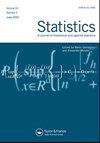匹配问题中的非强制错误
IF 1.2
4区 数学
Q2 STATISTICS & PROBABILITY
引用次数: 0
摘要
蒙特匹配问题的解决方案可以看作是在评估名义变量与金标准分类之间的一致性的实验中匹配数量的概率质量函数。[Vidal I, de Castro M. A]匹配问题的贝叶斯分析。[J] Stat Plan Inference. 2021; 212:194-200]通过考虑分配的时间顺序并将非强制性错误的数量添加到匹配数量中,提出了Montmort匹配问题的泛化。这些作者对这个问题进行了贝叶斯分析,但在本文中,我们从频率论的角度找到了这种新方法的解决方案。我们找到了匹配次数和非强制错误次数的二元概率质量函数。计算了非强迫误差数的边际分布,并用第二类斯特林数表示。此外,还证明了非强迫误差的分布与强迫误差的分布相等等基本性质。作为一个实际的结果,我们提出了一个新的实验和收集和分析数据的新方法,以评估名义变量和金标准分类之间的一致性。使用提出的方法分析了两个真实数据集。本文章由计算机程序翻译,如有差异,请以英文原文为准。
Unforced errors in the matching problem
The solution of the Montmort's matching problem can be seen as the probability mass function of the number of matches in an experiment for assessing the agreement between nominal variables and gold standard classifications. [Vidal I, de Castro M. A Bayesian analysis of the matching problem. J Stat Plan Inference. 2021;212:194–200] presented a generalization of the Montmort's matching problem by considering the chronological order in what assignments are made and counting the number of unforced errors additionally to the number of matches. These authors carried out a Bayesian analysis of the problem, but in this paper we found a solution of this new approach from a frequentist point of view. We found the bivariate probability mass function of the number of matches and the number of unforced errors. The marginal distribution of the number of unforced errors is computed and expressed in terms of the Stirling numbers of the second kind. Also, some elementary properties were proven, including that the distribution of the unforced errors is equal to that of forced errors. As a practical consequence, we propose a new experiment and a new way of collecting and analysing the data in order to assess the agreement between nominal variables and gold standard classifications. Two real data sets were analysed using the proposed methodology.
求助全文
通过发布文献求助,成功后即可免费获取论文全文。
去求助
来源期刊

Statistics
数学-统计学与概率论
CiteScore
1.00
自引率
0.00%
发文量
59
审稿时长
12 months
期刊介绍:
Statistics publishes papers developing and analysing new methods for any active field of statistics, motivated by real-life problems. Papers submitted for consideration should provide interesting and novel contributions to statistical theory and its applications with rigorous mathematical results and proofs. Moreover, numerical simulations and application to real data sets can improve the quality of papers, and should be included where appropriate. Statistics does not publish papers which represent mere application of existing procedures to case studies, and papers are required to contain methodological or theoretical innovation. Topics of interest include, for example, nonparametric statistics, time series, analysis of topological or functional data. Furthermore the journal also welcomes submissions in the field of theoretical econometrics and its links to mathematical statistics.
 求助内容:
求助内容: 应助结果提醒方式:
应助结果提醒方式:


